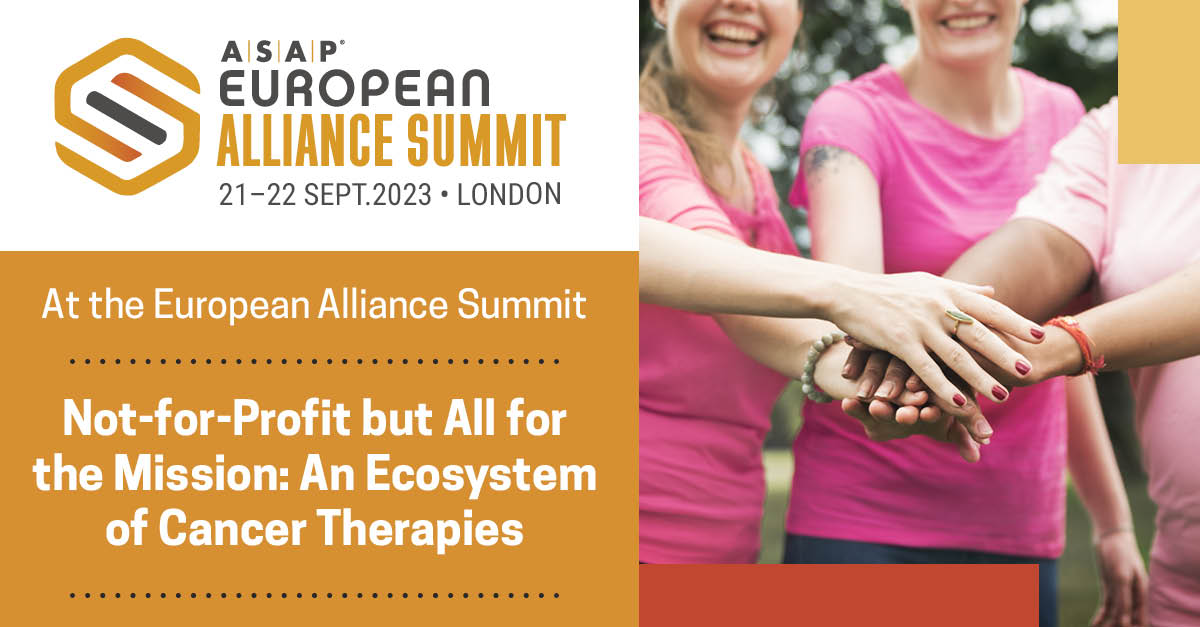Not-for-Profit but All for the Mission: An Ecosystem of Cancer Therapies
Ecosystems aren’t just for IT folks anymore. As we mentioned in this space a few weeks ago, they are taking root in biopharma just as they are in tech. Big Pharma, biotechs, contract manufacturers, contract research organizations, academics, and many others are collaborating in innumerable ways to bring drug candidates through the clinic and to market as fast as each country’s respective regulatory climate will allow.
At the 2023 ASAP European Alliance Summit this past September, attendees were treated to the nonprofit’s perspective on the vast network of organizations working to bring cancer therapies to patients. Julie Little, CSAP, director of alliances at Cancer Research Horizons, the innovation engine for Cancer Research UK, shed light on “The Role of Charities in Supporting Academic Research Through Creation of an Alliance Ecosystem” in a presentation that outlined her organization’s partner portfolio, partnering philosophy, and recent joint successes.
The Therapeutic Innovation organization within Cancer Research Horizons employs over 200 scientists and collaborates with industry, academic institutions, and three international research institutes—the Oncode Institute in the Netherlands, Sweden’s Karolinska Institute, and the Singapore-based Experimental Drug Development Center (EDDC). Leveraging its partners, the organization has brought 11 drugs to market, dispensed over 6,000 doses to patients, explored 160 drugs in early clinical-stage development, established 150 active licenses commercially, and formed 60 spinouts within the past decade. I guess that’s what happens when you invest $500 million into your alliance network in the span of four years!
The Novelty of “Team Science” and “Partnering at Scale”
Cancer Research Horizons also isn’t encumbered by some of the limitations many for-profit organizations encounter. For one, it can “embrace novelty” and pursue riskier projects that might not have the larger established potential markets that come with safer investments. Or as Little put it, her organization isn’t “here for me-too therapies.”
Because cancer initiatives tend to be “incredibly high-risk and incredibly challenging,” Cancer Research Horizons’ model lends itself to collaboration more readily than your average biopharma outfit’s. It’s why the organization preaches “team science,” leveraging great scientific minds across academic institutions and its own labs in order to run multiple projects simultaneously—or as Little described it, “partnering at scale.”
One Size Doesn’t Fit All; Multiple Partners Create Opportunities, Reduce Risk
Little illustrated how the organization puts these principles into practice by describing its activity with different partner segments. Cancer Research Horizons brings the aforementioned three academia partners together in various workshops in efforts to find “those synergies between those institutes, along with our network” and take “opportunities forward together,” she said. Early next year, these institutions will be part of Cancer Research Horizons’ liver cancer symposium, for example.
In a different example of this investment portfolio approach to alliance management—the practice of engaging in manifold alliances in order to “derisk” the fallout of individual collaborations going by the wayside—Little mentioned that her organization utilizes several different antibody platforms, including its own, simply because there is no “one-size-fits-all” platform. By having a foot in many doors, Cancer Research Horizons ensures that the academics it partners with have the “capability to translate their biology,” according to Little. In addition, Little brought up Cancer Research Horizons’ ASAP Alliance Excellence Award–winning Antibody Alliance Laboratory (AAL), a joint project with AstraZeneca.
Not a Linear Way of Getting to Market
Little said that Cancer Research Horizons’ model of convening academics and industry scientists as part of a startup-like process, in which all parties brainstorm new opportunities and determine the risks and issues associated with them, contrasts sharply with the “linear way of working in the past,” where an academic researcher comes up with an idea, validates it in the lab, and then seeks out a partner—or “fingers crossed, someone is interested in your science,” said Little. In the new model, Cancer Research Horizons might have multiple projects with a single academic or industry partner—one had up to 20 initiatives running simultaneously, Little recounted—with the goal of whittling that number down once the research makes the more promising ones apparent. Ultimately, this ecosystem seeks to produce marketable candidates that industry partners will want to take in-house.
“By working together like that you have a greater chance of success at the end of the day of something getting to the market,” said Little.
Veering Off on a Tangent Toward Compelling New Data
Of course, there are challenges in balancing relationships between very different types of partners.
“Culture is a big thing. Academics are traditionally less focused and have a tendency to go off on a tangent and develop their science,” said Little. She said that sometimes researchers in institutions of higher learning have to be reminded that all parties agreed to a work plan with a specific timeframe—and there’s “funding earmarked to do that.”
On the other side of the coin, “it’s also about the industry partner appreciating how academics operate, as well, and what they can bring to the table and giving them a level of freedom,” said Little. Industry partners must respect academic scientists’ desire to publish their work, provided that they respect the timing vis-à-vis the intellectual property at the center of the partnership. After all, pharma companies might reap some rewards if they give their academic partners a little room to roam.
“Veering off on a tangent can reveal really interesting new data, which we can bring into the alliance,” said Little. The important thing is to “work through the consequences” with academics and help them navigate that balance between sticking to the original scope of the agreement and casting an eye in a new direction that may or may not build on that original mission.

